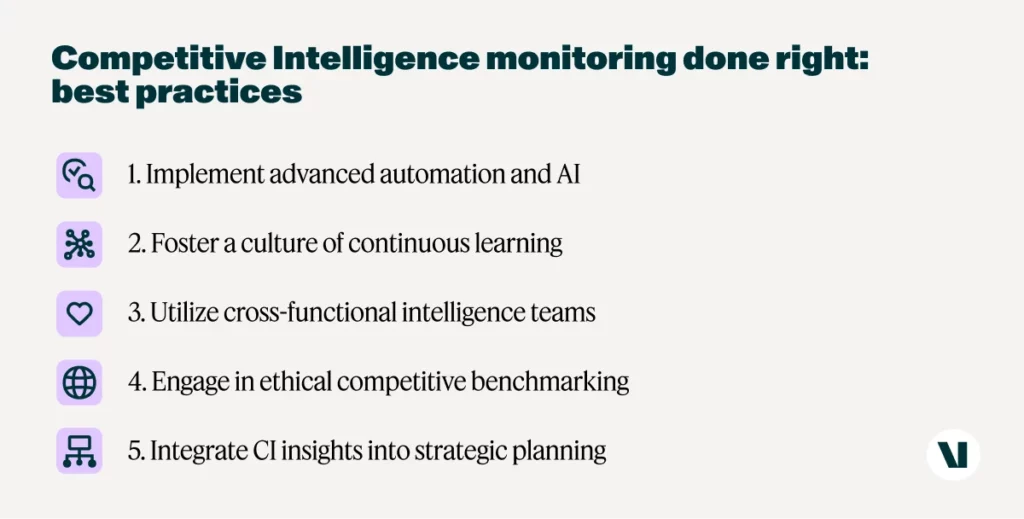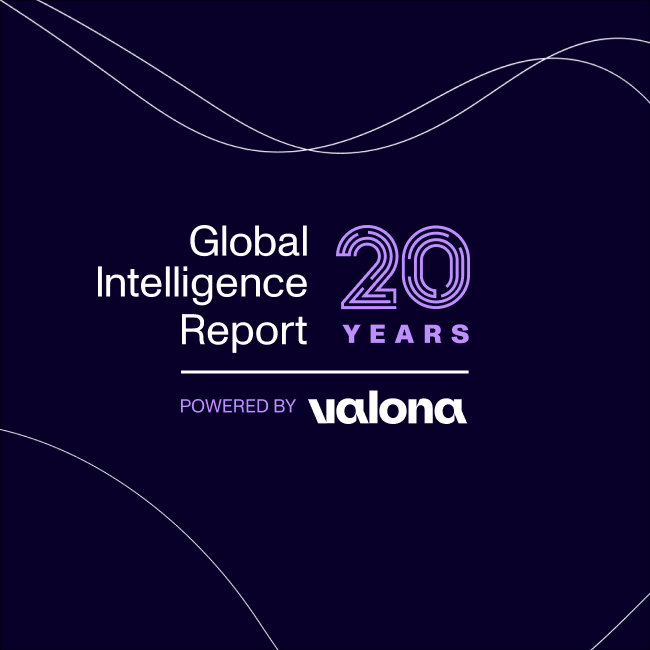
Best Practices for Competitive Intelligence Monitoring
Discover best practices for competitive intelligence monitoring. Learn essential metrics, AI tools, and strategies to stay ahead in a competitive field.
If you’re not effectively monitoring your competition, you’re leaving valuable insights on the table. Staying up to date on competitors’ actions, market trends, and industry shifts can give your business a serious edge. But simply collecting information isn’t enough—you need a structured approach to make sense of it all and use it strategically.
This article outlines the best practices to maximize your competitive intelligence monitoring.
Getting to grips with Competitive Intelligence monitoring
Competitive Intelligence (CI) monitoring is a critical tool for any business looking to stay ahead of market trends and competitors. It involves the ongoing process of gathering, analyzing, and using data about competitors and the overall market.
The goal is to guide your business strategy with up-to-date intelligence. CI monitoring collects information from various structured sources, including public records, digital channels, and market reports, helping businesses to stay informed.
CI monitoring supports proactive decision-making. By understanding competitors and market conditions, your business can anticipate market shifts, identify new opportunities, and refine strategies based on real-time insights.
This ability to foresee competitor moves or technological disruptions can be the difference between thriving and falling behind in today’s fast-moving industries. By aligning your business strategy with current market realities, CI monitoring also ensures long-term sustainability and helps mitigate business risks.
One of the greatest benefits of CI monitoring is that it strengthens your decision-making processes. Accurate, timely data lets you base strategic choices on facts instead of assumptions. Your business can remain competitive while maneuvering through unpredictable market conditions using this approach.
“Competitive Intelligence monitoring drives data-driven business strategies while requiring careful navigation of data challenges.”
However, CI monitoring comes with its own set of challenges:
- Data overload: With the vast amount of data available today, it’s easy to become overwhelmed. Without proper filtering, businesses might struggle to process the most relevant information.
- Data accuracy: Not all data is created equal. Ensuring the reliability of your sources is critical, as inaccurate data can lead to poor business decisions.
- Resource allocation: Balancing investment in automated CI tools and human expertise is tricky. While automation can streamline data collection, human analysis is often needed to interpret the data correctly.
- Timeliness: CI monitoring has to be continuous and up-to-date. Outdated data can quickly become irrelevant, rendering your intelligence ineffective.
- Cross-department integration: It can be difficult to ensure that CI insights are communicated effectively across different teams within your organization. Actionable intelligence has to reach decision-makers in a format they can use.
- Ethical concerns: Collecting competitive data has to always be done ethically and in compliance with legal regulations. Violating these rules can harm your company’s reputation.
- Rapid market changes: The business field is constantly evolving, which means your CI processes have to be flexible enough to adapt. Static CI models won’t cut it.
- Cross-department collaboration: Different teams within your organization might have different objectives. This can make it challenging to align how CI data is interpreted and used.
It’s clear that without the right processes in place, these challenges can undermine the effectiveness of CI monitoring.
Essential metrics to track for CI effectiveness
To ensure that your competitive intelligence (CI) monitoring delivers actionable insights, it’s important to track specific metrics that reflect both your company’s performance and the broader market dynamics.
One of the most critical metrics is market share and position analysis. By tracking your market share, you can evaluate how well your business is performing compared to competitors over time.
Shifts in market share indicate whether your strategies are allowing you to penetrate the market or whether competitors are gaining ground. This analysis also helps identify key competitors, their strengths, and where your company might be lagging.
Understanding your position in the market allows you to fine-tune your strategies for growth and ensure that you’re not losing competitive ground.
Another important metric is trend identification and adaptation. Recognizing emerging shifts in consumer behavior, technology, and industry practices is important for staying relevant.
By monitoring trends, you can anticipate changes in customer needs and regulatory environments, and adjust your product and service offerings accordingly. This supports proactive decision-making and fosters innovation, enabling your company to become a market leader in adapting to change.
Benchmarking performance against competitors is another key practice. This involves comparing your company’s performance metrics—such as revenue growth, customer satisfaction, and operational efficiency—against those of your competitors.
“The right metrics drive strategic decisions and foster innovation in competitive intelligence.”
Benchmarking helps identify areas where your company excels and where improvements are needed. Additionally, it helps you set realistic performance goals and ensures that your company remains competitive by understanding and adopting industry best practices.
Customer sentiment monitoring is also key. This involves tracking how customers perceive your brand and your competitors’ brands through social media, online reviews, and forums.
Monitoring customer sentiment provides real-time insights into brand reputation, helping you identify pain points in competitor offerings and find opportunities for differentiation.
This metric also informs marketing strategies and product improvements, which are critical for maintaining customer loyalty and improving the overall customer experience.
Competitive Intelligence monitoring done right: best practices

1. Implement advanced automation and AI
As data sources grow in complexity and volume, manual processes struggle to keep up. Implementing advanced automation ensures that data collection and processing are streamlined, reducing human error and saving significant time.
AI-powered tools take it a step further by improving the depth of analysis. A robust tool can identify patterns, trends, and insights that human analysts might overlook.
This allows you to gain a more comprehensive understanding of competitor behavior, market shifts, and emerging risks. With AI, you’re not just seeing what’s happening now, but also understanding why it’s happening.
A major benefit of automation is cost reduction. By automating repetitive tasks like data scraping, aggregation, and basic analysis, you reduce the labor costs associated with manual processes.
Advanced automation tools can quickly sift through large datasets without the need for constant human supervision, freeing up your time for more strategic activities.
AI also plays an important role in predictive analytics, which is key in forecasting competitor actions and market trends. By analyzing historical data and real-time inputs, AI models can help you anticipate future moves, enabling you to stay a step ahead in your industry.
Continuous, real-time monitoring is another advantage of integrating automation and AI into your CI efforts.
Automated systems can track significant changes in the competitive field and alert you as soon as important developments occur. This ensures that you can respond quickly, whether it’s to adjust your strategy or capitalize on new opportunities.
If integrating automation and AI into your competitive intelligence approach sounds essential to your strategy, Valona’s market intelligence software can be your ally. With features like real-time tracking, predictive analytics, and seamless data automation, our platform simplifies complex processes, letting you respond swiftly to market shifts and competitor moves.
2. Foster a culture of continuous learning
Fostering a culture of continuous learning helps your team stay adaptable in an increasingly dynamic business environment. A company-wide focus on learning encourages employees to stay curious, experiment, and use competitive insights to drive better decisions.
Continuous learning involves more than just keeping up with industry trends. It includes regular training sessions, workshops, and knowledge-sharing meetings. These activities help keep your team updated on the latest CI techniques and tools. You can set up:
- Periodic training programs to introduce new methods and software
- Workshops to discuss case studies of successful CI initiatives
- Cross-departmental meetings to share insights from different perspectives
Leadership plays a key role in this process. Your managers and executives need to set the tone by promoting a mindset of exploration, where employees feel safe to test new ideas and learn from both successes and failures.
When employees know that their learning is encouraged from the top, they are more likely to engage with CI insights actively.
This culture of learning also keeps your organization agile. As the competitive field shifts, companies that are slow to adapt get left behind. Continuous learning helps your team stay responsive and proactive, minimizing the risk of being caught off-guard by market changes or new competitors.
Finally, fostering this culture supports the ongoing improvement of your CI processes. By regularly incorporating feedback and new knowledge from the industry, you create a feedback loop that refines your competitive intelligence strategies over time.
3. Utilize cross-functional intelligence teams
Involving team members from various departments in your competitive intelligence (CI) monitoring efforts increases both the depth and breadth of the insights you gather.
Cross-functional intelligence teams, which include individuals from areas like marketing, sales, product development, and customer service, bring diverse expertise to the table. This diversity gives you a wider range of perspectives on what the competitive field looks like.
When team members from different departments collaborate on CI, they contribute unique viewpoints that can reveal risks and opportunities others might overlook. For example, a product development team might focus on technological advancements, while marketing could identify shifts in customer preferences.
Cross-functional teamwork also ensures that the intelligence you gather is more actionable across the entire organization. Each department interprets data in ways that are relevant to their specific roles and responsibilities.
This alignment helps you apply CI insights more effectively, making sure that the competitive insights inform decision-making in all areas, from product development to customer communication.
To get the most out of cross-functional teams, it’s important to have clear communication and shared goals. If every department is working towards the same objectives, they can better coordinate their efforts, ensuring that the competitive intelligence process is efficient and focused.
“Cross-functional teams enrich CI efforts by providing diverse perspectives and actionable insights.”
4. Engage in ethical competitive benchmarking
Ethical competitive benchmarking is a valuable practice when you aim to analyze your competitors’ strategies, products, or services without crossing legal or ethical lines. It relies only on publicly available and legally obtained data.
To engage in ethical benchmarking, focus on gathering information through sources like:
- Attending industry events and conferences
- Reading publicly accessible reports and whitepapers
- Monitoring competitors’ public content such as blogs, social media, and press releases
This approach lets you extract valuable lessons from competitors’ successes and failures. By understanding their strengths and weaknesses, you can adjust your own strategies to align with industry standards or even set new benchmarks.
“Ethical benchmarking strengthens your strategy without compromising your company’s integrity.”
Maintaining ethical standards is important. Failing to do so can harm your company’s reputation and erode the trust of stakeholders. On the other hand, a strong ethical stance builds long-term credibility with customers, partners, and the industry at large.
5. Integrate CI insights into strategic planning
CI is not just about gathering information on competitors but using that information to make informed decisions that shape your company’s future.
For this to be effective, you need to ensure that CI insights are regularly incorporated into your decision-making processes. This means setting up clear, structured channels through which CI teams can present their findings directly to key decision-makers.
By embedding CI into strategic planning, your business strategies are aligned with real-time market trends, competitor activities, and emerging opportunities. This alignment helps ensure that your long-term goals and tactical initiatives are based on actual market conditions, not just internal assumptions.
“Aligning CI with your strategic planning ensures you’re ahead of market changes, not just reacting to them.”
It also supports better risk management, enabling your company to anticipate challenges before they become serious threats. For instance, if CI reveals that a competitor is about to launch a disruptive product, you can adjust your strategy to mitigate the potential impact.
To ensure success, your CI teams should have established protocols for consistently delivering insights to leadership. These insights should then be used to inform critical decisions, from resource allocation to market positioning. When CI is a regular part of your strategic planning, you create cohesive, data-driven strategies that boost your competitiveness.
Integrating CI insights into strategic planning offers several clear benefits:
- Informed Decision-Making: Regularly incorporating CI ensures that your decisions are grounded in current market realities.
- Risk Management: Using CI allows you to anticipate competitors’ moves and market shifts, helping you mitigate risks early.
- Strategic Alignment: CI insights help align your business objectives with the competitive field, ensuring that your strategies are not only ambitious but also attainable.
- Enhanced Competitiveness: Data-driven strategies give your company a competitive edge, allowing you to maneuver through market disruptions more effectively.
6. Monitor emerging technologies and disruptions
As new technologies and business models continue to evolve, they can quickly reshape industries, forcing companies to adapt or risk falling behind. By actively tracking these developments, you can gain early insights into shifts that might impact your market and prepare accordingly.
One key reason to monitor emerging technologies is that they often lead to significant industry changes. Whether it’s the rise of automation, artificial intelligence, or blockchain, these innovations can shift customer expectations, redefine value propositions, or even create entirely new markets. Keeping a close eye on these advancements ensures that you’re not caught off guard.
“Monitoring emerging technologies provides both protection and opportunity for strategic growth.”
Another benefit is that staying aware of new technologies and potential disruptors allows you to respond proactively, not reactively. Proactive adaptation can help you maintain or even strengthen your market position, while those who react too late might lose ground to competitors.
In addition to protecting your position, identifying technological trends can present opportunities for growth. For example, tracking emerging technologies might reveal:
- Opportunities for strategic partnerships with tech innovators.
- Potential acquisitions that could improve your company’s capabilities.
- New product development possibilities aligned with evolving customer needs.
This practice also supports your company’s long-term vision by ensuring it stays ahead of industry trends. Strategic foresight, driven by monitoring technological disruptions, enables you to make informed decisions that contribute to innovation and keep your business competitive.
Conclusion
Effective competitive intelligence (CI) monitoring is essential for enterprises seeking to maintain a competitive edge. By implementing best practices like leveraging AI and automation, fostering a culture of learning, using cross-functional teams, adhering to ethical benchmarking, integrating insights into strategic plans, and tracking emerging technologies, businesses can turn raw data into actionable strategies.
These efforts help ensure that CI monitoring remains robust, timely, and strategic, empowering companies to make informed decisions and adapt proactively in a fast-paced market.
To strengthen your CI strategy and put these best practices into action, Valona Intelligence offers a solution designed to streamline your efforts.
With capabilities like real-time tracking, predictive analytics, and automated data processing, our platform makes it easier to transform complex data into strategic insights. Book a demo today to see how we can help enhance your CI approach!
FAQ
How to measure competitive intelligence?
Measure competitive intelligence by tracking key metrics such as market share analysis, trend identification, competitor benchmarking, and customer sentiment monitoring. These metrics help evaluate a company’s position, monitor performance relative to competitors, and adapt strategies based on real-time insights and industry shifts.
What is the intelligence monitoring process?
The intelligence monitoring process involves collecting, analyzing, and interpreting data about competitors and market trends. It includes gathering data from structured sources, analyzing it for insights, and distributing actionable intelligence to decision-makers to guide strategic business decisions.
What is competitive media monitoring?
Competitive media monitoring is the practice of tracking and analyzing public content from various media channels to understand competitors’ actions, brand mentions, and market trends. This helps businesses assess their position, adapt strategies, and respond proactively to market developments.
How do you do media monitoring?
Media monitoring is done by collecting data from various sources like news outlets, social media, and blogs. This information is analyzed for mentions of competitors, trends, and consumer sentiment, providing actionable insights that support competitive strategies and market positioning.
What are the 4 basic steps to monitoring?
The four basic steps to monitoring are:
Data Collection: Gathering relevant information from various sources.
Data Analysis: Processing and interpreting the collected data.
Insight Generation: Extracting actionable insights from the analysis.
Distribution: Sharing insights with decision-makers to inform strategy.



